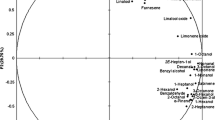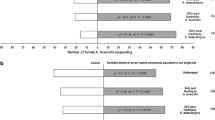Abstract
The defense strategy of an insect toward natural enemies can include a trait that appears at first sight to contradict its defensive function. We explored phylogeny, chemistry, and defense efficiency of a peculiar group of hymenopteran sawfly larvae where this contradiction is obvious. Pseudodineurini larvae live in leaf mines that protect them from some enemies. Disturbed larvae also emit a clearly perceptible lemon-like odor produced by ventral glands, although the mine hampers the evaporation of the secretion. The mine could also lead to autointoxication of a larva by its own emitted volatiles. Citral was the major component in all Pseudodineurini species, and it efficiently repels ants. We conclude that full-grown larvae that leave their mine to pupate in the soil benefit from citral by avoiding attacks from ground-dwelling arthropods such as ants. In some species, we also detected biosynthetically related compounds, two 8-oxocitral diastereomers (i.e., (2E,6E)- and (2E,6Z)-2,6-dimethylocta-2,6-dienedial). Synthetic 8-oxocitral proved to be a potent fungicide, but not an ant repellent. The discrete distribution of 8-oxocitral was unrelated to species grouping in the phylogenetic tree. In contrast, we discovered that its presence was associated with species from humid and cold zones but absent in species favoring warm and dry environments. The former should be protected by 8-oxocitral when faced with a fungal infestation while crawling into the soil. Our work shows the importance of integrating knowledge about behavior, morphology, and life history stages for understanding the complex evolution of insects and especially their defense strategies.





Similar content being viewed by others
References
Altenhofer, E. 2003. Minierende Blattwespen (Hym.: Symphyta): ihre Minenformen, Wirtspflanzen, Ökologie und Biologie. Gredleriana 3:5–24.
Altenhofer, E. and Pschorn-Walcher, H. 2006. Zur Faunistik, Biologie und Parasitierung der minierenden Blattwespen der Tribus Pseudodineurini (Hymenoptera: Tenthredinidae). pp. 73–82, in S. M. Blank, S. Schmidt, A. Taeger (eds). Recent Sawfly Research: Synthesis and Prospects. Goecke & Evers, Keltern (Germany).
Blum, M. S. 1981. Chemical Defenses of Arthropods. Academic Press, New York.
Boevé, J.-L. 1988. Stratégies défensives des larves de Nématines (Hymenoptera, Tenthredinidae) vis-à-vis de leurs prédateurs. PhD dissertation. Université Libre de Bruxelles.
Boevé, J.-L. 2008. Sawflies (Hymenoptera: Tenthredinidae), pp. 3252-3257, in J. L. Capinera (ed.). Encyclopedia of Entomology, Second Edition. Springer.
Boevé, J.-L. and Heilporn, S. 2009. Secretion of the ventral glands in Craesus sawfly larvae. Biochem. Syst. Ecol. 36:836–841.
Boevé, J.-L. and Pasteels, J. M. 1985. Modes of defense in nematine sawfly larvae. J. Chem. Ecol. 11:1019–1036.
Boevé, J.-L., Braekman, J.-C., Daloze, D., Houart, M., and Pasteels, J. M. 1984. Defensive secretions of Nematinae larvae (Symphyta - Tenthredinidae). Experientia. 40:546–547.
Boevé, J.-L., Dettner, K., Franke, W., Meyer, H., and Pasteels. J. M. 1992. The secretion of the ventral glands in Nematus sawfly larvae. Biochem. Syst. Ecol. 20:107–111.
Boevé, J.-L., Gfeller, H., Schlunegger, U. P., and Francke, W. 1997. The secretion of the ventral glands in Hoplocampa sawfly larvae. Biochem. Syst. Ecol. 25:195–201.
Chan, K. C., Jewell, R.A., Nutting, W. H., and Rapoport, H. 1968. The synthesis and stereochemical assignment of cis- and trans-2-methyl-2-pentenoic acid and the corresponding esters, aldehydes, and alcohols. J. Org. Chem. 33:3382–3385.
Clinical and Laboratory Standards Institute/National Committee for Clinical Laboratory Standards. 2002a. Reference method for broth dilution antifungal susceptibility testing of yeasts. Approved Standard document M27-A2. Clinical and Laboratory Standards Institute/National Committee for Clinical Laboratory Standards Institute, Wayne P.A.
Clinical And Laboratory Standards Institute/National Committee For Clinical Laboratory Standards. 2002b. Reference method for broth dilution antifungal susceptibility testing of filamentous fungi. Approved Standard document M38-A. Clinical and Laboratory Standards Institute/National Committee for Clinical Laboratory Standards Institute, Wayne P.A.
Connor, E. F. and Taverner, M. P. 1997. The evolution and adaptive significance of the leaf-mining habit. Oikos 79:6–25.
Deacon, J. W. 1997. Fungal parasites of humans, insects and nematodes. pp. 254–272, in Modern Mycology. Blackwell Science Ed.
Drummond, A. J. and Rambaut, A. 2007. BEAST: Bayesian evolutionary analysis by sampling trees. BMC Evol. Biol. 7:214.
Eisner, T. 1970. Chemical defense against predation in arthropods, pp. 157–217 in E. Sondheimer, J. B. Simeone (eds). Chemical Ecology. Academic Press, New York.
Evans, D. L. and Schmidt, J. O. (eds.). 1990. Insect Defenses: Adaptive Mechanisms and Strategies of Prey and Predators. State University of New York Press, Albany, New York.
Guilford, T. 1990. The evolution of aposematism, pp. 23–61, in D. L. Evans and J. O. Schmidt (eds.). Insect Defenses: Adaptive Mechanisms and Strategies of Prey and Predators. State University of New York Press, Albany, New York.
Hall, R. A. and Papierok, B. 1982. Fungi as biological control agents of arthropods of agricultural and medical importance. Parasitology 84:205–240.
Hering, E. M. 1935-1937. Die Blattminen Mittel- und Nord-Europas einschließlich Englands. Bestimmungstabellen aller von Insektenlarven der verschiedenen Ordnungen erzeugten Minen. Neubrandenburg 1–6:1-631.
Hering, E. M. 1951. Biology of the Leaf Miners. Junk, Gravenhage.
Katoh, K. and Toh, H. 2008. Improved accuracy of multiple ncRNA alignment by incorporating structural information into a MAFFT-based framework. BMC Bioinformatics 9:212.
Katoh, K., Misawa, K., Kuma, K., and Miyata, T. 2002. MAFFT: a novel method for rapid multiple sequence alignment based on fast Fourier transform. Nucleic Acids Res. 30:3059-3066.
Kuwahara, Y., Leal, W. S., Suzuki, T., Maeda, M., and Masutami, T. 1989. Antifungal activity of Caloglyphus polyphyllae sex pheromone and other mite exudates. Naturwissenschaften 76:578–579.
Li, Y., Huang, C., Li, W., and Li, Y. (1997) A facile total synthesis of (3R,7RS)-3,7,11-trimethyl-10-oxododecanoic acid. Synth. Comm. 27:4341–4348.
Lima, I. O., De Araújo, G., Oliveira, R., De O. Lima, E., De Souza, E. L., Porto Farias, N., and De Fátima Navar, D. 2005. Inhibitory effect of some phytochemicals in the growth of yeasts potentially causing opportunistic infections. Braz. J. Pharmac. Sc. 41:199–203.
Moore, S. J., Lenglet, A., and Hill, N. 2007. Plant-based insect repellents, in M. Debboun, S. P. Frances, and D. Strickman (eds.). Insect Repellents: Principles, Methods, and Use. CRC Press, Taylor & Francis Group, Boca Raton.
Normark, B. B., Jordal, B. H., and Farrell, B. D. 1999. Origin of a haplodiploid beetle lineage. Proc. R. Soc. Lond. B 266:2253–2259.
Nyman, T., Zinovjev, A. G., Vikberg, V., and Farrell, B. D. 2006. Molecular phylogeny of the sawfly subfamily Nematinae (Hymenoptera: Tenthredinidae). Syst. Entomol. 31:569–583.
Nyman, T., Bokma, F., and Kopelke, J.-P. 2007. Reciprocal diversification in a complex plant-herbivore-parasitoid food web. BMC Biology 5:49
Omura, K. and Swern, D. 1978. Oxidation of alcohols by “activated” dimethyl sulfoxide. A preparative, steric and mechanistic study. Tetrahedron 34:1651–1660.
Pasteels, J. M., Grégoire, J.-C., and Rowell-Rahier, M. 1983. The chemical ecology of defense in arthropods. Annu. Rev. Entomol. 28:263–289.
Pezzolesi, L. S. W. and Hager, B. J. 1994. Ant predation on two species of birch leaf-mining sawflies. Am. Midl. Nat. 131:156–168.
Posada, D. 2008. jModelTest: Phylogenetic Model Averaging. Mol. Biol. Evol. 25:1253–1256.
Price, P. W. and Pschorn-Walcher, H. 1988. Are galling insects better protected against parasitoids than exposed feeders? A test using tenthredinid sawflies. Ecol. Entomol. 13:195–205.
Ronquist, F. and Huelsenbeck, J. P. 2003. MrBayes 3: Bayesian phylogenetic inference under mixed models. Bioinformatics 19:1572–1574.
Ruxton, G. D. and Sherratt, T. N. 2006. Aggregation, defence and warning signals: the evolutionary relationship. Proc. R. Soc. B 273:2417–2424.
Sabini, L. I., Gabrielli, P. S., Torres, C. V., Escobar, F. M., Cacciabue, M., Rovera, M., and Kolb, N. 2006. Study of the cytotoxic and antifungal activity of the essential oil of Elyonurus muticus against Candida spp. Mol. Medic. Chem. 11:31–33.
Schmidt, S., Driverb, F., and De Barroc, P. 2006. The phylogenetic characteristics of three different 28 S rRNA gene regions in Encarsia (Insecta, Hymenoptera, Aphelinidae). Organ. Divers. Evol. 6:127–139.
Seifert, B. 1988. A taxonomic revision of the Myrmica species of Europe, Asia Minor, and Caucasia (Hymenoptera, Formicidae). Abh. Naturkundemus. Görlitz 63:1–75.
Simon, C., Frati, F., Beckenbach, A., Crespi, B., Liu, H., and Flook, P. 1994. Evolution, weighting, and phylogenetic utility of mitochondrial gene sequences and a compilation of conserved polymerase chain reaction primers. Ann. Entomol. Soc. Am. 87:651–701
Swofford, D. L. 2002. PAUP*. Phylogenetic Analysis Using Parsimony (*and other Methods), Version 4. Sunderland, Massachusetts, Sinauer Associates.
Taeger, A. and Blank, S. M. 2008. ECatSym - Electronic World Catalog of Symphyta (Insecta, Hymenoptera). Program version 3.9, data version 34 (05.09.2008). Digital Entomological Information, Müncheberg.
Vartak, P. H., Tungikar, V. B., and Sharma, R. N. 1994. Comparative repellent properties of certain chemicals against mosquitoes, house flies and cockroaches using modified techniques. J. Comm. Dis. 26:156–160.
Veith, M., Dettner, K., and Boland, W. 1996. Stereochemistry of an alcohol oxidase from the defensive secretion of larvae of the leaf beetle Phaedon armoraciae. Tetrahedron 52:6601–6612.
Viramo, J. 1969. Zur Kenntnis der Miniererfauna Finnlands. Über die Wirtspflanzen und die Verbreitung der minierenden Blattwespen (Hym., Tenthredinoidea). Ann. Entomol. Fenn. 35:3–44.
Whitman, D. W., Blum, M. S., and Alsop, D. W. 1990. Allomones: chemicals for defense, pp. 289–351, in D.L. Evans and J.O. Schmidt (eds.). Insect Defenses: Adaptive Mechanisms and Strategies of Prey and Predators. State University of New York Press, Albany, New York.
Zinovjev, A. G. and Vikberg, V. 1998. On the biology of the Nematinae with hiding larvae (Hymenoptera, Symphyta, Tenthredinidae). Beitr. Entomol. 48:145–155.
Acknowledgements
JLB performed the GC–MS analyses in the lab of Monika Hilker (Berlin, Germany), with the technical assistance of Frank Müller. Filip De Block provided JLB with ants. Many thanks, also, to the collectors of sawfly specimens used in the genetic analyses and to Tommi Nyman, Herbert R. Jacobson, and two anonymous reviewers for critical and helpful reading of the manuscript. For phylogenetic analyses, funding was provided by the Joint Experimental Molecular Unit (project ECES_PSEU) that is supported by the Belgian Science Policy Office.
Author information
Authors and Affiliations
Corresponding author
Rights and permissions
About this article
Cite this article
Boevé, JL., Sonet, G., Nagy, Z.T. et al. Defense by Volatiles in Leaf-Mining Insect Larvae. J Chem Ecol 35, 507–517 (2009). https://doi.org/10.1007/s10886-009-9627-3
Received:
Revised:
Accepted:
Published:
Issue Date:
DOI: https://doi.org/10.1007/s10886-009-9627-3




